Optimizing PV-Hosting Capacity with the Integrated Employment of Dynamic Line Rating and Voltage Regulation
Abstract
1. Introduction
- Instead of using SLR to optimize the PVHC, an integrated approach of DLR with voltage regulation is introduced to enhance PVHC. The DLR is calculated considering the real meteorological data, and a simulation model to optimize the PVHC is developed. A real LVDN in Sri Lanka is considered to evaluate the effectiveness of the proposed method.
- The simulation model is integrated with a PV re-phasing approach to further stretch the PVHC as the PV re-phasing has not been used before when optimizing PVHC.
2. Methodology
2.1. Evaluation of DLR
2.2. Optimizing the PV Generation
2.2.1. Voltage Constraint
2.2.2. Thermal Constraint
2.2.3. Power Factor Constraint
2.2.4. Active Power Generation Constraint
2.3. Rpc of PV Inverters
2.4. Parallel Operation of PV Inverters and OLTC
2.5. Re-Phasing Approach
3. Case Studies
3.1. Test Cases and Scenarios
- Optimized PV values with SLR and voltage regulation with the OLTC (Base case);
- Optimized PV values with DLR and voltage regulation with the OLTC;
- Optimized PV values with DLR and coordinated voltage regulation using OLTC and RPC;
- Optimized PV values with DLR with voltage regulation using OLTC and RPC and re-phasing.
3.2. Test Network
4. Simulation Results and Discussion
4.1. Optimized PV Values with SLR and Voltage Regulation with the OLTC (Base Case)
4.2. Optimized PV Values with DLR and Voltage Regulation with the OLTC
4.3. Optimized PV Values with DLR and Coordinated Voltage Regulation Using OLTC & RPC
4.4. Optimized PV Values with DLR with Voltage Regulation Using OLTC and RPC and Re-Phasing
5. Conclusions
Author Contributions
Funding
Institutional Review Board Statement
Informed Consent Statement
Data Availability Statement
Acknowledgments
Conflicts of Interest
Abbreviations
| DLR | Dynamic Line Rating |
| LV | Low Voltage |
| LVDN | Low Voltage Distribution Network |
| MV | Medium Voltage |
| OLTC | On-load Tap Changer |
| PCC | Point of Common Coupling |
| PV | Photovoltaic |
| PVHC | Photovoltaic Hosting Capacity |
| RPC | Reactive Power Compensation |
| SLR | Static Line Rating |
References
- Dovi, V.; Battaglini, A. Energy Policy and Climate Change: A Multidisciplinary Approach to a Global Problem. Energies 2015, 8, 13473–13480. [Google Scholar] [CrossRef]
- The Paris Agreement. Available online: https://unfccc.int/ndc-information/the-paris-agreement (accessed on 18 September 2022).
- Erdiwansyah; Mahidin; Husin, H.; Nasaruddin; Zaki, M.; Muhibbuddin. A critical review of the integration of renewable energy sources with various technologies. Prot. Control Mod. Power Syst. 2021, 6, 3. [Google Scholar] [CrossRef]
- REN21. RENEWABLES 2022: GLOBAL STATUS REPORT; REN21 Secretariat: Paris, France, 2022. [Google Scholar]
- Shaikh, M.R.S.; Shaikh, S.; Waghmare, S.B.; Labade, S.; Tekale, A. A Review Paper on Electricity Generation from Solar Energy. Int. J. Res. Appl. Sci. Eng. Technol. 2017, 5, 1884–1889. [Google Scholar] [CrossRef]
- Peters, L.; Madlener, R. Economic evaluation of maintenance strategies for ground-mounted solar photovoltaic plants. Appl. Energy 2017, 199, 264–280. [Google Scholar] [CrossRef]
- Wang, Q.; Zhu, Z.; Wu, G.; Zhang, X.; Zheng, H. Energy analysis and experimental verification of a solar freshwater self-produced ecological film floating on the sea. Appl. Energy 2018, 224, 510–526. [Google Scholar] [CrossRef]
- Cole, W.; Lewis, H.; Sigrin, B.; Margolis, R. Interactions of rooftop PV deployment with thecapacity expansion of the bulk power system. Appl. Energy 2016, 168, 473–481. [Google Scholar] [CrossRef]
- U.S. Solar Market Insight. Available online: https://www.seia.org/research-resources/solar-market-insight-report-2021-year-review (accessed on 19 September 2022).
- Tonkoski, R.; Turcotte, D.; EL-Fouly, T.H.M. Impact of High PV Penetration on Voltage Profiles in Residential Neighborhoods. IEEE Trans. Sustain. Energy 2012, 3, 518–527. [Google Scholar] [CrossRef]
- Almeida, D.; Pasupuleti, J.; Ekanayake, J. Performance evaluation of PV penetration at different locations in a LV distribution network connected with an off-load tap changing transformer. Indones. J. Electr. Eng. Comput. Sci. 2021, 21, 987–993. [Google Scholar] [CrossRef]
- Alyami, S.; Wang, Y.; Wang, C.; Zhao, J.; Zhao, B. Adaptive Real Power Capping Method for Fair Overvoltage Regulation of Distribution Networks With High Penetration of PV Systems. IEEE Trans. Smart Grid. 2014, 5, 2729–2738. [Google Scholar] [CrossRef]
- Aziz, T.; Ketjoy, N. PV Penetration Limits in Low Voltage Networks and Voltage Variations. IEEE Access 2017, 3, 16784–16792. [Google Scholar] [CrossRef]
- Torquato, R.; Salles, D.; Pereira, C.O.; Meira, P.C.M.; Freitas, W. A Comprehensive Assessment of PV Hosting Capacity on Low-Voltage Distribution Systems. IEEE Trans. Power Deliv. 2018, 3, 1002–1012. [Google Scholar] [CrossRef]
- Alanzi, S.S.; Kamel, R.M. Photovoltaic Maximum Penetration Limits on Medium Voltage Overhead and Underground Cable Distribution Feeders: A Comparative Study. Energies 2021, 14, 3843. [Google Scholar] [CrossRef]
- Wang, S.; Chen, S.; Ge, L.; Wu, L. Distributed Generation Hosting Capacity Evaluation for Distribution Systems Considering the Robust Optimal Operation of OLTC and SVC. IEEE Trans. Sustain. Energy 2016, 7, 1111–1123. [Google Scholar] [CrossRef]
- Home-Ortiz, J.M.; Macedo, L.H.; Vargas, R.; Romero, R.; Mantovai, J.R.S.; Catalao, J.P.S. Increasing RES Hosting Capacity in Distribution Networks Through Closed-Loop Reconfiguration and Volt/VAr Control. IEEE Trans. Ind. Appl. 2022, 58, 4424–4435. [Google Scholar] [CrossRef]
- Tewari, T.; Mohapatra, A.; Anand, S. Coordinated Control of OLTC and Energy Storage for Voltage Regulation in Distribution Network With High PV Penetration. IEEE Trans. Sustain. Energy 2020, 12, 262–272. [Google Scholar] [CrossRef]
- Almeida, D.; Pasupuleti, J.; Ekanayake, J.; Karunarathne, E. Mitigation of overvoltage due to high penetration of solar photovoltaics using smart inverters volt/var control. Indones. J. Electr. Eng. Comput. Sci. 2020, 19, 1259–1266. [Google Scholar] [CrossRef]
- Zhang, C.; Xu, Y. Hierarchically-Coordinated Voltage/VAR Control of Distribution Networks Using PV Inverters. IEEE Trans. Smart Grid. 2020, 12, 2942–2953. [Google Scholar] [CrossRef]
- 1547-2018; IEEE Standard for Interconnection and Interoperability of Distributed Energy Resources with Associated Electric Power Systems Interfaces. IEEE Power and Energy Society: Piscataway, NJ, USA, 2018. Available online: https://ieeexplore.ieee.org/document/8332112 (accessed on 20 September 2022).
- Common Functions for Smart Inverters, Version 2. Available online: https://www.epri.com/research/products/1023059 (accessed on 20 September 2022).
- Almeida, D.; Pasupuleti, J.; Ekanayake, J. Comparison of Reactive Power Control Techniques for Solar PV Inverters to Mitigate Voltage Rise in Low-Voltage Grids. Electronics 2021, 10, 1569. [Google Scholar] [CrossRef]
- Wang, Y.; Zhao, T.; Ju, C.; Xu, Y.; Wang, P. Two-Level Distributed Volt/Var Control Using Aggregated PV Inverters in Distribution Networks. IEEE Trans. Power Deliv. 2019, 35, 1844–1855. [Google Scholar] [CrossRef]
- Aziz, T.; Ketjoy, N. Enhancing PV Penetration in LV Networks Using Reactive Power Control and On Load Tap Changer With Existing Transformers. IEEE Access 2017, 6, 2683–2691. [Google Scholar] [CrossRef]
- Arshad, A.; Lehtonen, M. A Stochastic Assessment of PV Hosting Capacity Enhancement in Distribution Network Utilizing Voltage Support Techniques. IEEE Access 2019, 7, 46461–46471. [Google Scholar] [CrossRef]
- Fatima, S.; Puvi, V.; Lehtonen, M. Review on the PV Hosting Capacity in Distribution Networks. Energies 2020, 7, 4576. [Google Scholar] [CrossRef]
- Arshad, A.; Linder, M.; Lehtonen, M. An Analysis of Photo-Voltaic Hosting Capacity in Finnish Low Voltage Distribution Networks. Energies 2017, 10, 1702. [Google Scholar]
- Kikuchi, S.; Machida, M.; Tamura, J.; Imanka, M.; Baba, J.; Iioka, D.; Miura, K.; Takagi, M.; Asano, H. Hosting capacity analysis of many distributed photovoltaic systems in future distribution networks. In Proceedings of the IEEE Innovative Smart Grid Technologies-Asia (ISGT-Asia) 2017, Auckland, New Zealand, 4–7 December 2017; pp. 2378–8542. [Google Scholar]
- Hoke, A.; Butler, R.; Hambrick, J.; Kroposki, B. Steady-State Analysis of Maximum Photovoltaic Penetration Levels on Typical Distribution Feeders. IEEE Trans. Sustain. Energy 2012, 4, 350–357. [Google Scholar] [CrossRef]
- Erdinç, F.G.; Erdinç, O.; Yumurtacı, R.; Catalão, J.P.S. A Comprehensive Overview of Dynamic Line Rating Combined with Other Flexibility Options from an Operational Point of View. Energies 2020, 13, 6563. [Google Scholar] [CrossRef]
- Bhattarai, B.P.; Gentle, J.P.; McJunkin, T.; Hill, P.J.; Myers, K.S.; Abboud, A.W.; Renwick, R.; Hengst, D. Improvement of Transmission Line Ampacity Utilization by Weather-Based Dynamic Line Rating. IEEE Trans. Power Deliv. 2018, 33, 1853–1863. [Google Scholar] [CrossRef]
- Hajeforosh, S.; Khatun, A.; Bollen, M. Enhancing the hosting capacity of distribution transformers for using dynamic component rating. Int. J. Electr. Power Energy Syst. 2022, 142, 142–615. [Google Scholar] [CrossRef]
- Li, Y.; Wang, Y.; Kang, C.; Song, J.; He, G.; Chen, Q. Improving distributed PV integration with dynamic thermal rating of power distribution equipment. iScience 2022, 25, 104808. [Google Scholar] [CrossRef]
- Carpinelli, G.; Mottola, F.; Proto, D.; Varilone, P. Minimizing unbalances in low-voltage microgrids: Optimal scheduling of distributed resources. Appl. Energy 2017, 191, 170–182. [Google Scholar]
- Taher, S.A.; Karimi, M.H. Optimal reconfiguration and DG allocation in balanced and unbalanced distribution systems. Ain Shams Eng. J. 2014, 5, 735–749. [Google Scholar] [CrossRef]
- Ji, H.; Wang, C.; Li, P.; Zhao, J.; Song, G.; Ding, F.; Wu, J. An enhanced SOCP-based method for feeder load balancing using the multi-terminal soft open point in active distribution networks. Appl. Energy 2017, 208, 986–995. [Google Scholar] [CrossRef]
- Kaveh, M.R.; Hooshmand, R.A.; Madni, S.M. Simultaneous optimization of re-phasing, reconfiguration and DG placement in distribution networks using BF-SD algorithm. Appl. Soft Comput. 2018, 62, 1044–1055. [Google Scholar] [CrossRef]
- Zhu, J.; Chow, M.; Zhang, F. Phase balancing using mixed-integer programming [distribution feeders]. IEEE Trans. Power Syst. 1998, 13, 1487–1492. [Google Scholar]
- Hooshmand, R.A.; Soltani, S. Fuzzy Optimal Phase Balancing of Radial and Meshed Distribution Networks Using BF-PSO Algorithm. IEEE Trans. Power Syst. 2011, 27, 47–57. [Google Scholar] [CrossRef]
- Bandara, W.G.C.; Godaliyadda, G.M.R.I.; Ekanayake, M.P.B.; Ekanayake, J.B. Coordinated photovoltaic re-phasing: A novel method to maximize renewable energy integration in low voltage networks by mitigating network unbalances. Appl. Energy 2020, 280, 116022. [Google Scholar] [CrossRef]
- Karunarathne, E.; Wijethunge, A.; Ekanayake, J. Enhancing PV Hosting Capacity Using Voltage Control and Employing Dynamic Line Rating. Energies 2022, 15, 134. [Google Scholar] [CrossRef]
- Ismael, S.M.; Aleem, S.H.E.A.; Abdelaziz, A.Y.; Zobaa, A.F. State-of-the-art of hosting capacity in modern power systems with distributed generation. Renew. Energy 2019, 130, 1002–1020. [Google Scholar] [CrossRef]
- Mulenga, E.; Bollen, M.H.J.; Etherden, N. A review of hosting capacity quantification methods for photovoltaics in low voltage distribution grids. Int. J. Electr. Power Energy Syst. 2020, 115, 105445. [Google Scholar] [CrossRef]
- Han, C.; Lee, D.; Song, S.; Jang, G. Probabilistic Assessment of PV Hosting Capacity Under Coordinated Voltage Regulation in Unbalanced Active Distribution Networks. IEEE Access 2022, 10, 35578–35588. [Google Scholar] [CrossRef]
- Sahu, S.K.; Ghosh, D. Hosting Capacity Enhancement in Distribution System in Highly Trenchant Photo-Voltaic Environment: A Hardware in Loop Approach. IEEE Access 2019, 8, 14440–14451. [Google Scholar] [CrossRef]
- Abad, M.S.S.; Ma, J. Photovoltaic Hosting Capacity Sensitivity to Active Distribution Network Management. IEEE Trans. Power Syst. 2020, 36, 107–117. [Google Scholar] [CrossRef]
- 738-2012; Calculating the Current-Temperature Relationship of Bare Overhead Conductors. IEEE Power and Energy Society: Piscataway, NJ, USA, 2012.
- Wijethunga, A.; Ekanayake, J.B.; Wijayakulasooriya, J.V. Collector cable design based on dynamic line rating for wind energy applications. J. Natl. Sci. Found. 2018, 46, 31–40. [Google Scholar] [CrossRef]
- Hameed, M.F.O.; Hassan, A.K.S.O.; Elqenawy, A.E.; Obayya, S.S.A. Trust Region Algorithm for Dispersion Optimization of Photonic Crystal Fibers. J. Light. Technol. 2017, 35, 3810–3818. [Google Scholar] [CrossRef]
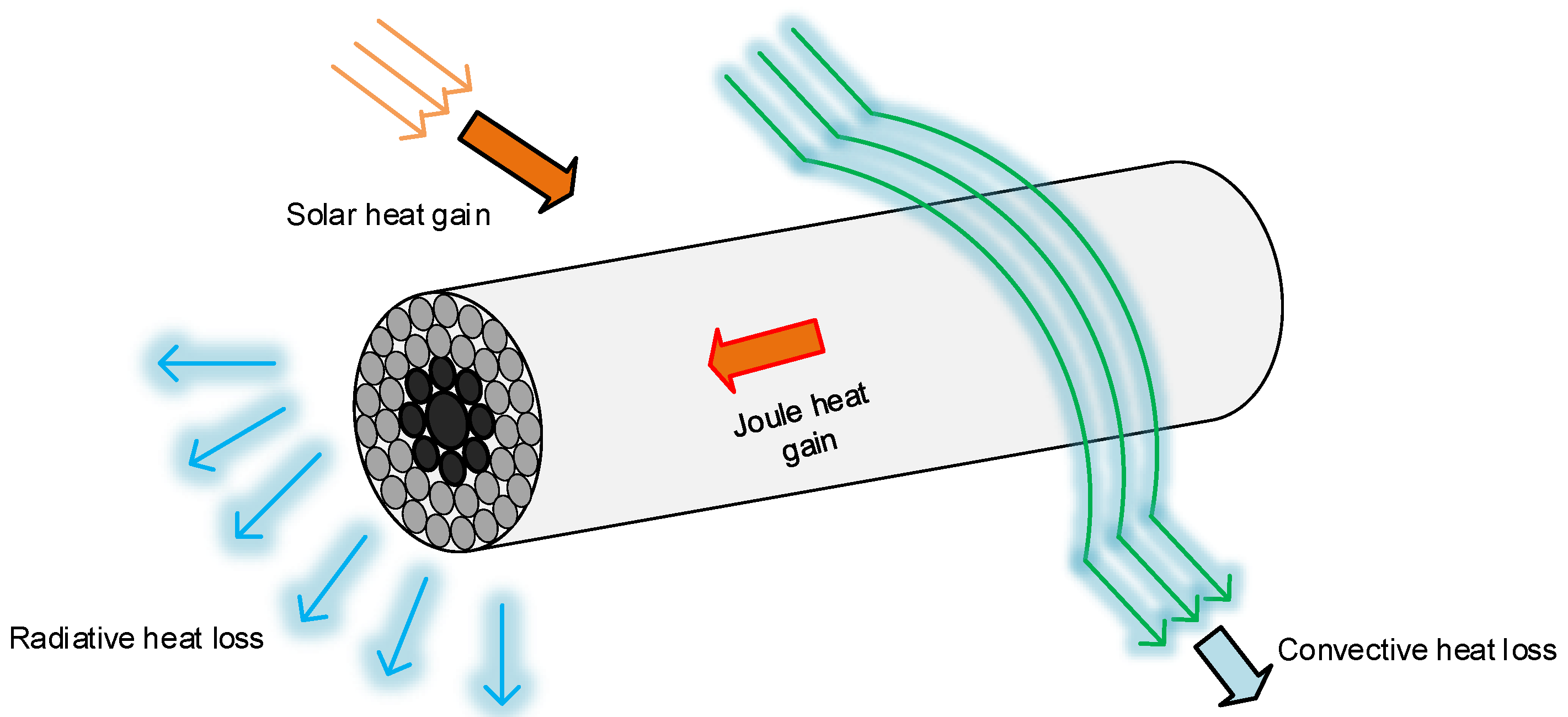



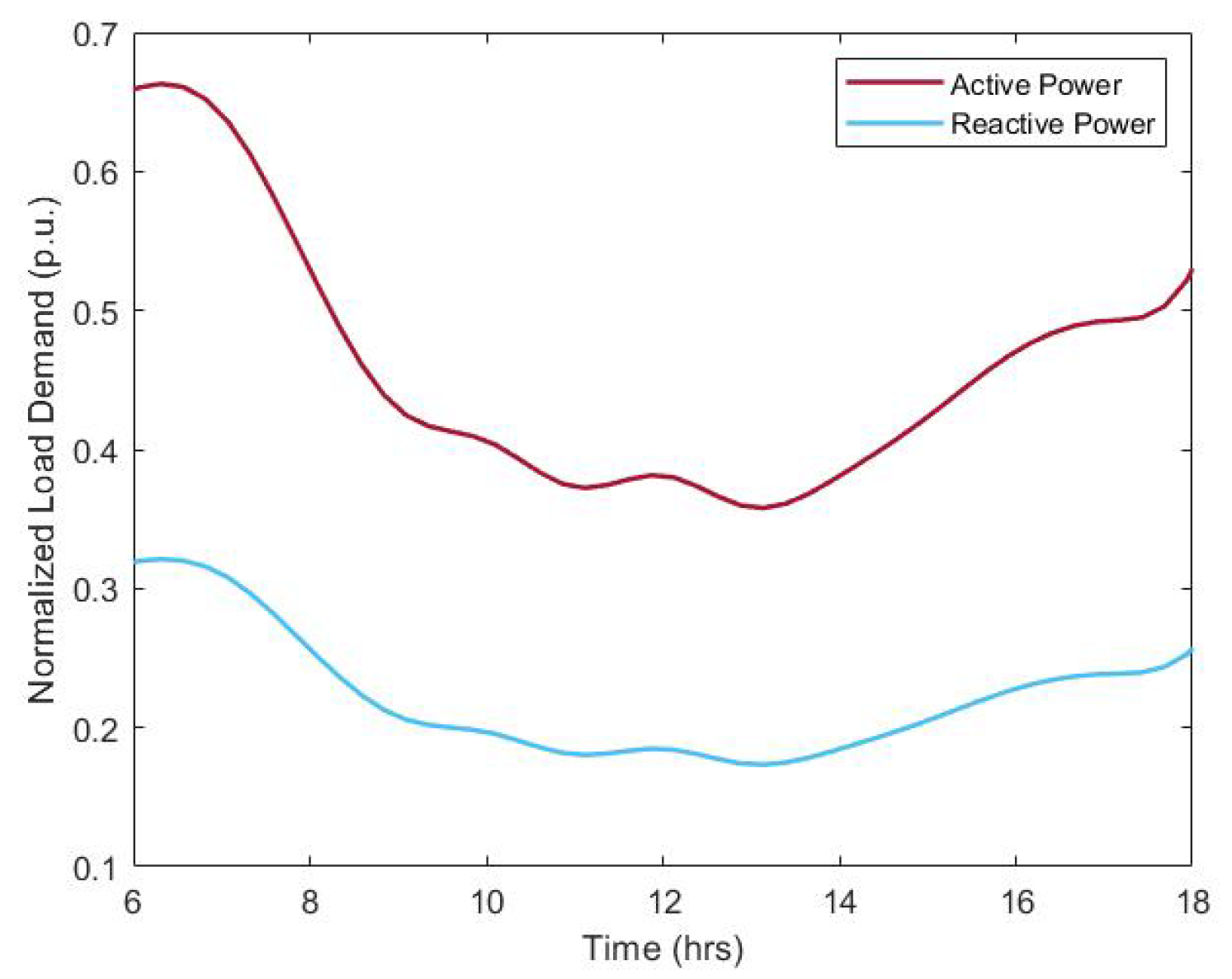
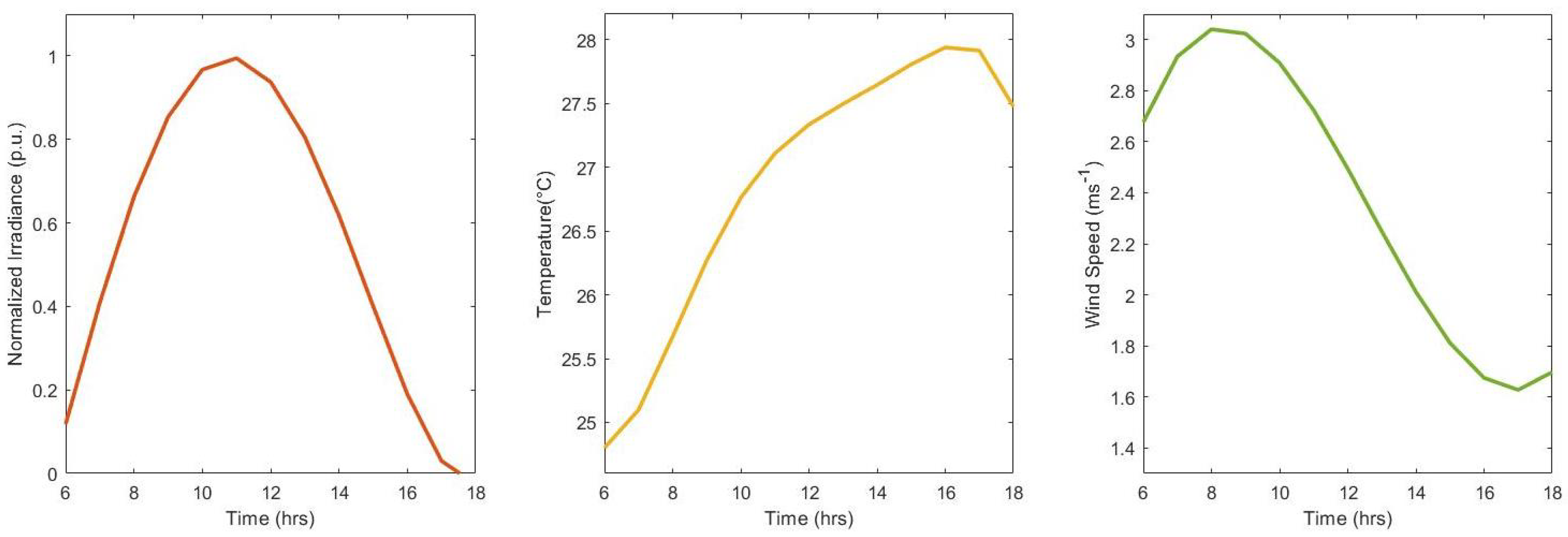


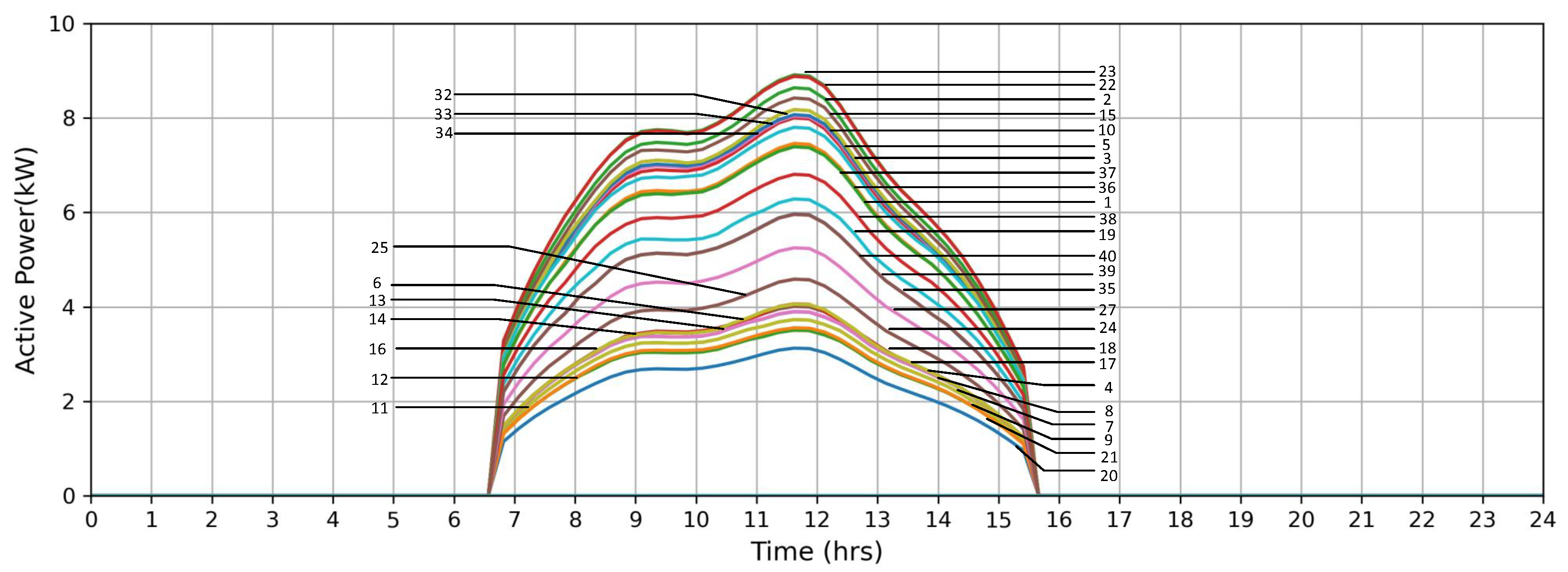
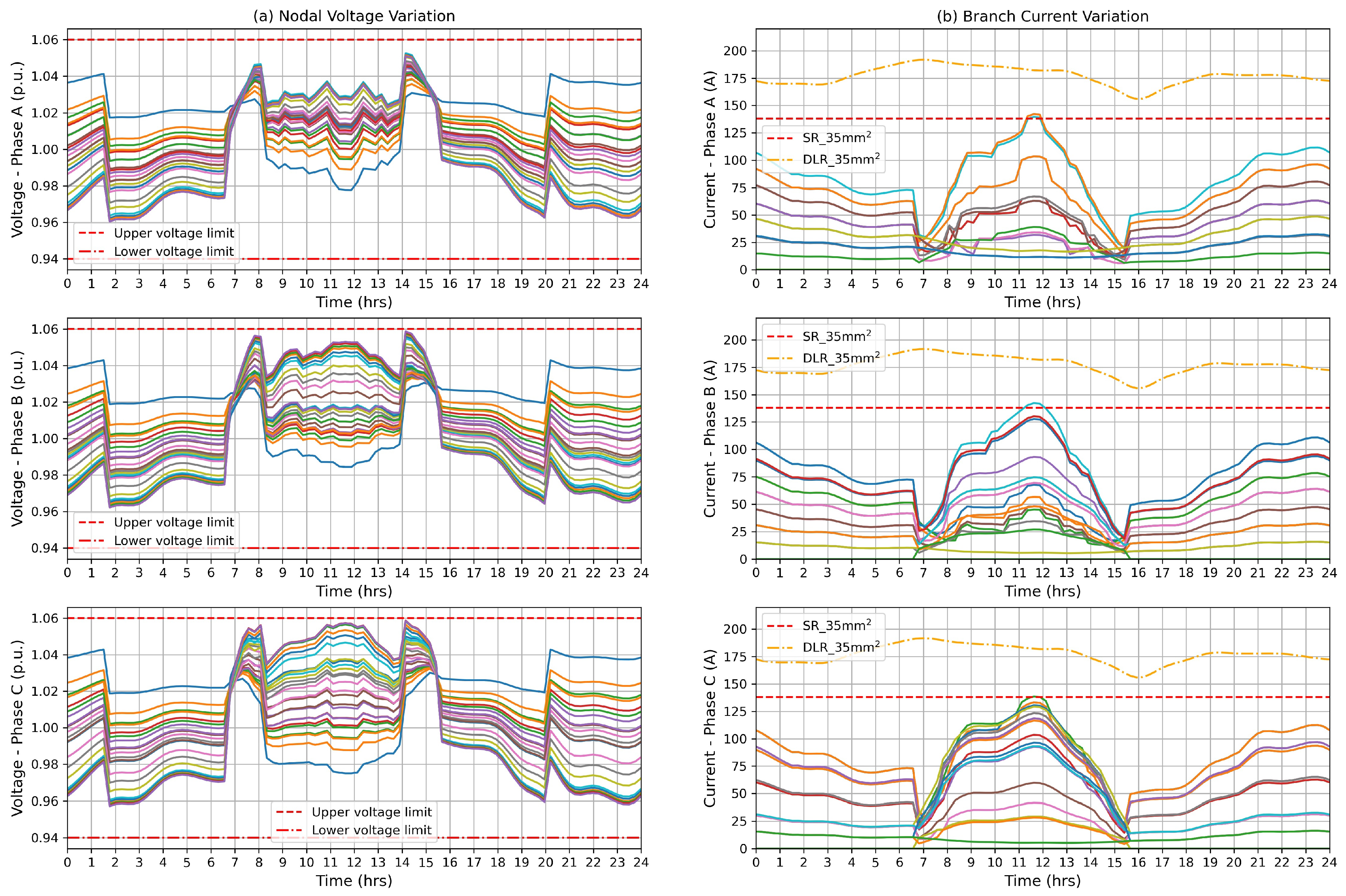


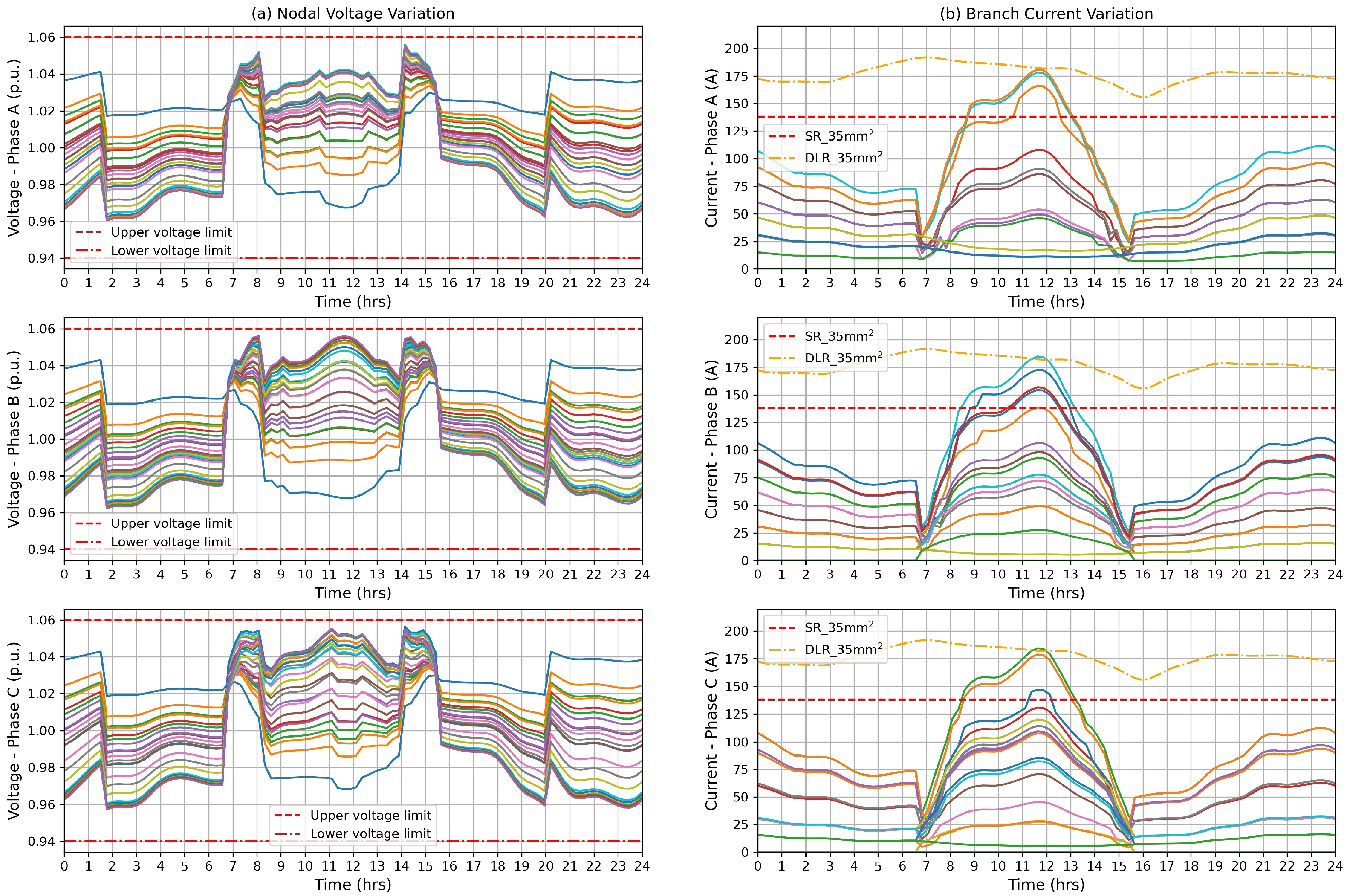

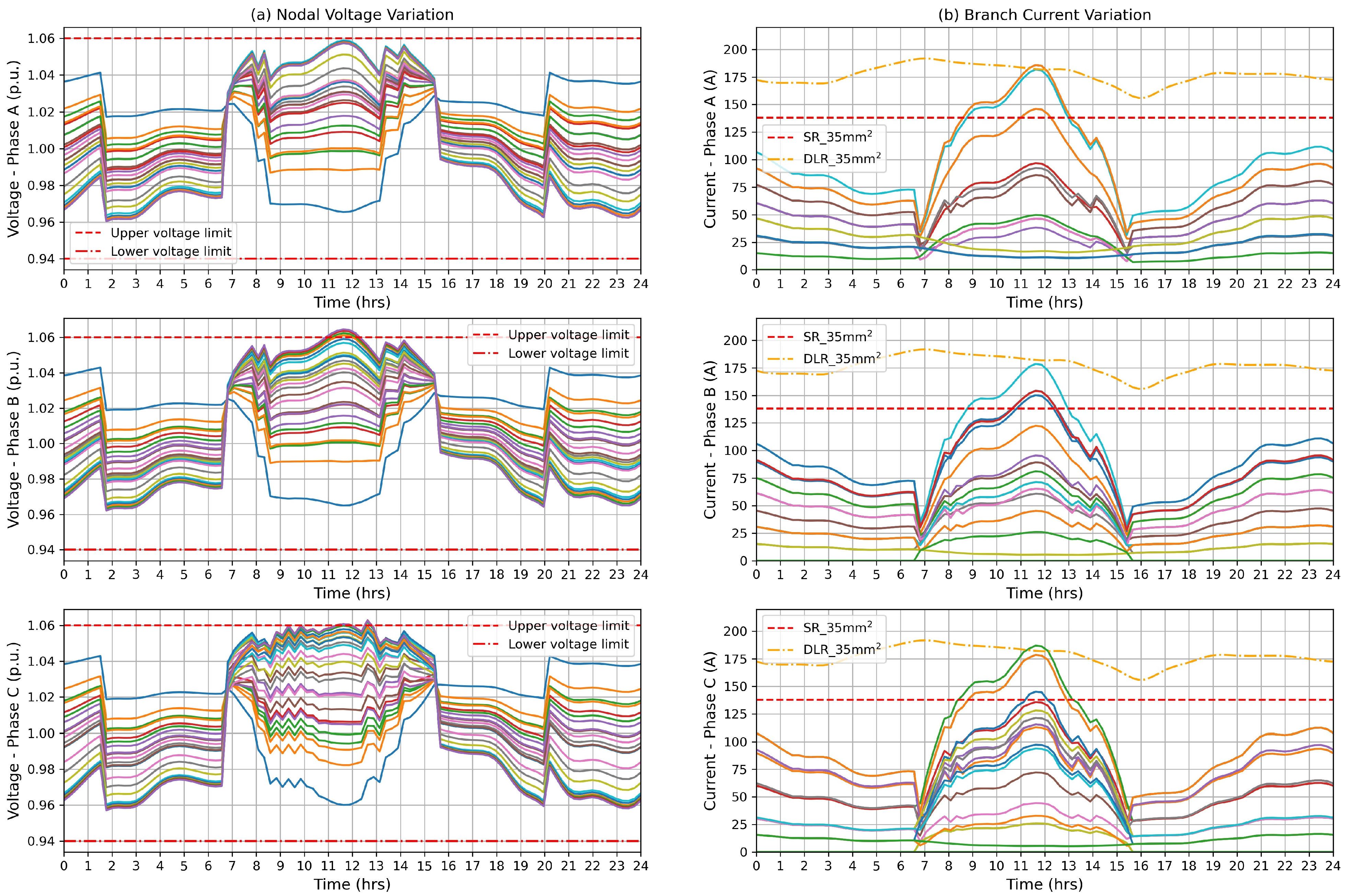

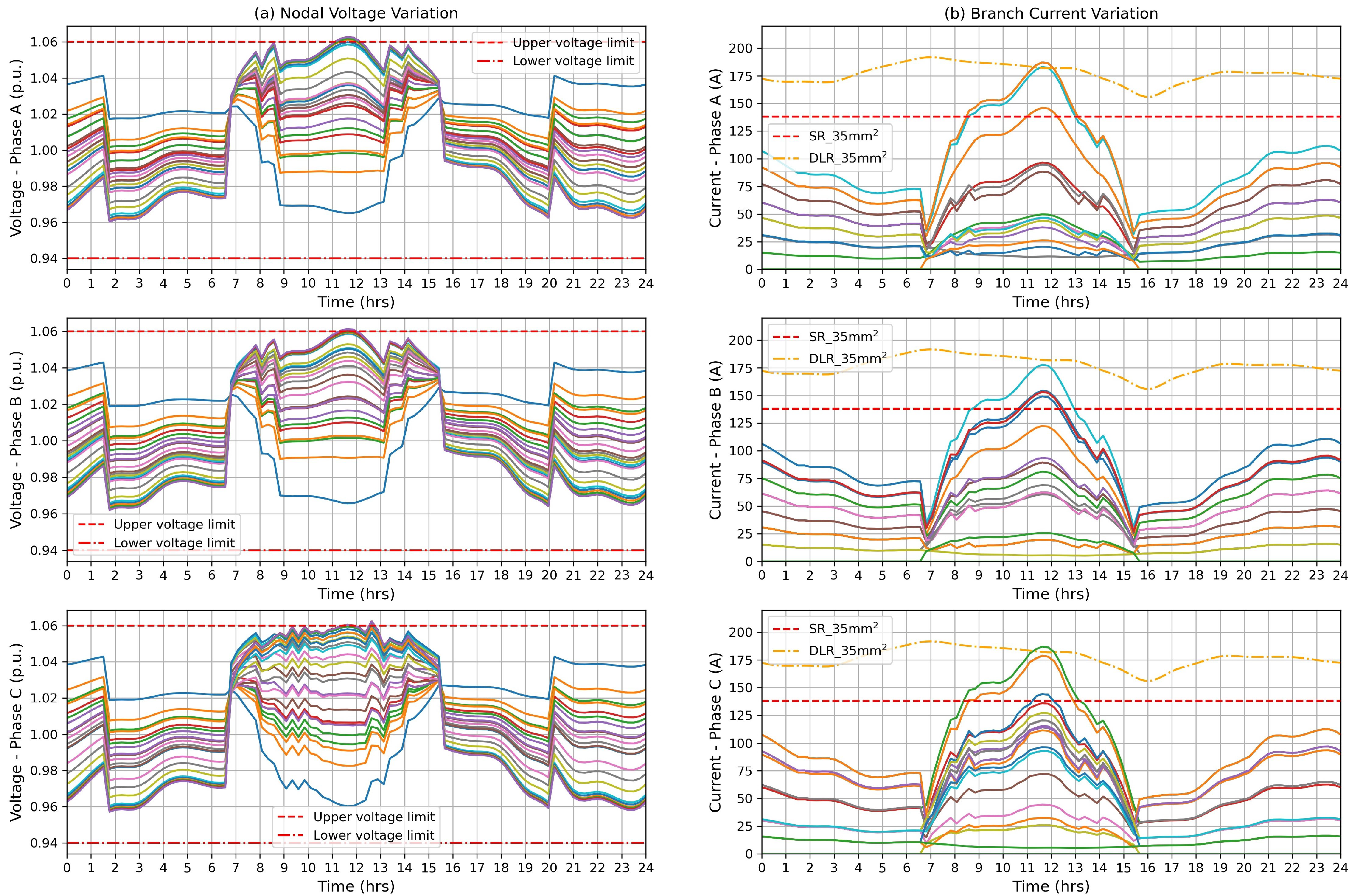
| Line | ||||
|---|---|---|---|---|
| From Node | To Node | Length (m) | Number of Houses at “To Node” | Number of PV Units at “To Node” |
| 1 | 2 | 36.0 | 3 | 3 |
| 2 | 3 | 20.0 | 1 | 1 |
| 3 | 4 | 20.0 | 2 | 2 |
| 4 | 5 | 25.0 | 2 | 2 |
| 5 | 6 | 25.0 | 2 | 2 |
| 6 | 7 | 26.0 | 2 | 2 |
| 7 | 8 | 28.0 | 2 | 2 |
| 8 | 9 | 23.0 | 2 | 2 |
| 9 | 10 | 22.5 | 2 | 2 |
| 10 | 11 | 22.5 | 1 | 1 |
| 2 | 12 | 20.0 | 1 | 1 |
| 12 | 13 | 20.0 | 1 | 1 |
| 13 | 14 | 20.0 | 1 | 1 |
| 14 | 15 | 32.0 | 1 | 1 |
| 15 | 16 | 25.5 | 2 | 2 |
| 16 | 17 | 25.5 | 2 | 1 |
| 17 | 18 | 25.5 | 2 | 0 |
| 18 | 19 | 25.5 | 2 | 0 |
| 19 | 20 | 26.0 | 2 | 2 |
| 20 | 21 | 10.2 | 1 | 1 |
| 21 | 22 | 10.2 | 1 | 1 |
| 22 | 23 | 10.2 | 2 | 2 |
| 23 | 24 | 10.2 | 2 | 2 |
| 24 | 25 | 10.2 | 1 | 1 |
| Case | Optimized PV Integration (kW) | PVHC Increment (%) |
|---|---|---|
| SLR with OLTC | 204.4 | Base case |
| DLR with OLTC | 288.0 | 40.9 |
| DLR with OLTC, RPC and re-phasing | 313.8 | 53.5 |
Publisher’s Note: MDPI stays neutral with regard to jurisdictional claims in published maps and institutional affiliations. |
© 2022 by the authors. Licensee MDPI, Basel, Switzerland. This article is an open access article distributed under the terms and conditions of the Creative Commons Attribution (CC BY) license (https://creativecommons.org/licenses/by/4.0/).
Share and Cite
Dissanayake, R.; Wijethunge, A.; Wijayakulasooriya, J.; Ekanayake, J. Optimizing PV-Hosting Capacity with the Integrated Employment of Dynamic Line Rating and Voltage Regulation. Energies 2022, 15, 8537. https://doi.org/10.3390/en15228537
Dissanayake R, Wijethunge A, Wijayakulasooriya J, Ekanayake J. Optimizing PV-Hosting Capacity with the Integrated Employment of Dynamic Line Rating and Voltage Regulation. Energies. 2022; 15(22):8537. https://doi.org/10.3390/en15228537
Chicago/Turabian StyleDissanayake, Ramitha, Akila Wijethunge, Janaka Wijayakulasooriya, and Janaka Ekanayake. 2022. "Optimizing PV-Hosting Capacity with the Integrated Employment of Dynamic Line Rating and Voltage Regulation" Energies 15, no. 22: 8537. https://doi.org/10.3390/en15228537
APA StyleDissanayake, R., Wijethunge, A., Wijayakulasooriya, J., & Ekanayake, J. (2022). Optimizing PV-Hosting Capacity with the Integrated Employment of Dynamic Line Rating and Voltage Regulation. Energies, 15(22), 8537. https://doi.org/10.3390/en15228537








